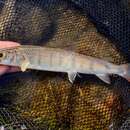Diagnostic Description
(
Inglês
)
fornecido por Fishbase
Small cross-shaped dark spots on head and sides of body; maxilla reaching backward behind rear edge of eyes; scales oval, minute without radial grooves and rings extremely clear; adipose fin well-developed; pyloric caecum 205-219 (Ref. 45563). Distinguished from other species of Salmonidae in central and eastern Europe by the combination of the following characters: teeth on vomer and palatine in a continuous, horse-shoe-shaped band; 173-288 scales in midlateral row (107-164 pored scales); small round dark spots on head and dark x-shaped or/and half-moon-shaped spots on body; head long (22-25% SL) and dorsally flattened; very long jaws, maxilla length 42-50% HL; in adults, maxilla reaching posterior margin of eye; shallow cylindrical body; caudal deeply emarginate, reddish in adults; large size in undisturbed areas; and 9-18 gill rakers, usually 11-13 (Ref. 59043).
- licença
- cc-by-nc
- direitos autorais
- FishBase
- Recorder
- Grace Tolentino Pablico
Life Cycle
(
Inglês
)
fornecido por Fishbase
Females dig a redd about 1.0-1.5 m in diameter. Eggs, 5-6 mm in diameter, hatch after 28-38 days. Alevins stay in gravel until yolk sac is absorbed after 10-15 days while young first remain near spawning site, then move downstream (Ref. 59043).
- licença
- cc-by-nc
- direitos autorais
- FishBase
Migration
(
Inglês
)
fornecido por Fishbase
Potamodromous. Migrating within streams, migratory in rivers, e.g. Saliminus, Moxostoma, Labeo. Migrations should be cyclical and predictable and cover more than 100 km.
- licença
- cc-by-nc
- direitos autorais
- FishBase
Trophic Strategy
(
Inglês
)
fornecido por Fishbase
Carnivorous, feeds on fishes, snakes, frogs, rodents, aquatic birds. Lives in fast-flowing streams below 150°C.
- licença
- cc-by-nc
- direitos autorais
- FishBase
- Recorder
- Grace Tolentino Pablico
Biology
(
Inglês
)
fornecido por Fishbase
Adults inhabit piedmont and montane cold rivers with high oxygen concentrations. They prefer to live in deeper holes with slow current for periods of reduced activity (day time, winter), but also lower reaches, estuaries, cold lakes and reservoirs. Both juveniles and adults are territorial. Adults frequently occur within their own restricted territory (deep holes below rapids and waterfalls, confluence of small tributaries, below bridge pillar or large rocks, bank excavations), which they abandon only foraging and spawning. Young individuals do not maintain permanent territory. Juveniles occur in fast-flowing waters, prey on drifting invertebrates and shift to fish diet after 1-3 years. Adults feed on fishes and terrestrial vertebrates. They breed in shallow places with fast current on pebble bottom, immediately downstream of large deep pools, often in small river tributaries. Usually undertake upriver migration for spawning in the upper reaches of tributaries. Can overcome quite high obstacles while migrating to spawning sites. Eggs, 5-6 mm in diameter, hatch after 28-38 days. Alevins stay in gravel until yolk sac is absorbed after 10-15 days while young first remain near spawning site, then move downstream. Larger immature individuals of 2-4 years of age live in same sites as adults but separately below groups of adults or in smaller holes. Life span reaches up to about 20 years (Ref. 59043). Threatened due to habitat loss, pollution and over harvesting (Ref. 58490), including angling tourism (Ref. 59043).
- licença
- cc-by-nc
- direitos autorais
- FishBase
Importance
(
Inglês
)
fornecido por Fishbase
fisheries: commercial; aquaculture: experimental; gamefish: yes
- licença
- cc-by-nc
- direitos autorais
- FishBase

